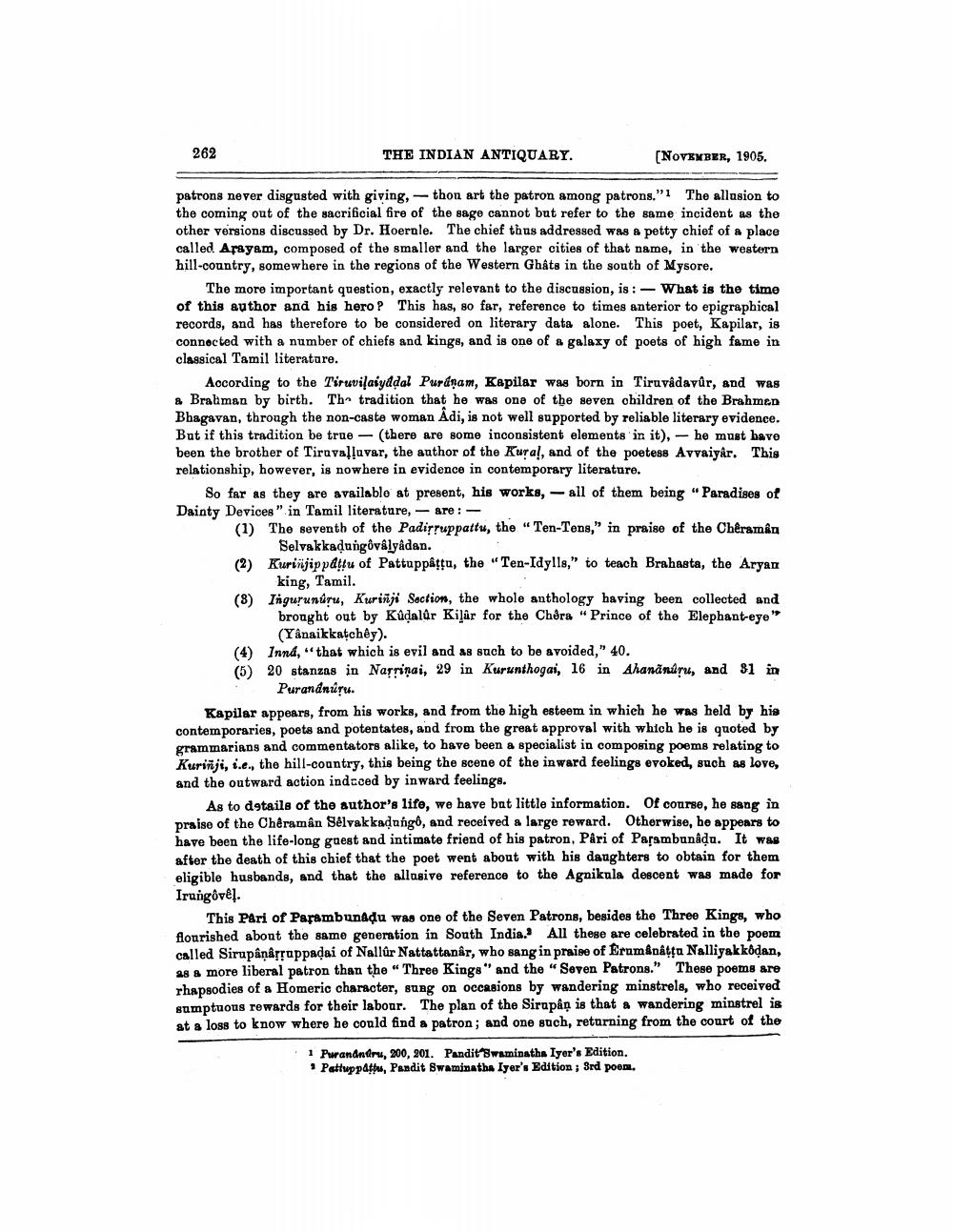________________
262
THE INDIAN ANTIQUARY.
(NOVEMBER, 1905.
patrons never disgusted with giving, - thon art the patron among patrons." The allusion to the coming out of the sacrificial fire of the sage cannot but refer to the same incident as the other versions discussed by Dr. Hoernle. The chief thus addressed was a petty chief of a place called Arayam, composed of the smaller and the larger cities of that name, in the western hill-country, somewhere in the regions of the Western Ghâts in the south of Mysore.
The more important question, exactly relevant to the discussion, is :- What is the time of this author and his hero? This has, so far, reference to times anterior to epigraphical records, and has therefore to be considered on literary data alone. This poet, Kapilar, is connected with a number of chiefs and kings, and is one of a galaxy of poets of high fame in classical Tamil literatare.
According to the Tiruvilaiyddal Puránam, Kapilar was born in Tiruvadavûr, and was & Braliman by birth. Th- tradition that he was one of the seven children of the Brahmen Bhagavan, through the non-caste woman Adi, is not well supported by reliable literary evidence. But if this tradition be true - (there are some inconsistent elements in it), - he must have been the brother of Tiruvalluvar, the author of the Kura!, and of the poetess Avvaiyar. This relationship, however, is nowhere in evidence in contemporary literature.
So far as they are available at present, his works, - all of them being "Paradises of Dainty Devices" in Tamil literature, - are: -
(1) The seventh of the Padisruppattu, the "Ten-Tens," in praise of the Chéramin
Selvakkadungovalyadan. (2) Kurinjippattu of Pattuppåtu, the "Ten-Idylls," to teach Brahasta, the Aryan
king, Tamil. (8) Ingurunúru, Kurinji Section, the whole anthology having been collected and
brought out by Kudalûr Kilûr for the Chöra "Prince of the Elephant-eye"
(Yånaikkatchey). (4) Innd, that which is evil and as such to be avoided," 40. (5) 20 stanzas in Narriņai, 29 in Kurunthogai, 16 in Ahananúru, and 81 in
Purandnúru. Kapilar appears, from his works, and from the high esteem in which he was held by his contemporaries, poets and potentates, and from the great approval with which he is quoted by grammarians and commentators alike, to have been a specialist in composing poems relating to Kurinji, i.e., the hill-country, this being the scene of the inward feelings evoked, such as love, and the outward action induced by inward feelings.
As to details of the author's life, we have but little information. Of course, he sang in praise of the Chéraman Selvakkadungô, and received a large reward. Otherwise, he appears to have been the life-long guest and intimate friend of his patron. Pari of Parambunadu. It was after the death of this chief that the poet went about with his daughters to obtain for them eligible husbands, and that the allusive reference to the Agnikula descent was made for Irungovej.
This Pari of Parambunadu was one of the Seven Patrons, besides the Three Kings, who flourished abont the same generation in South India. All these are celebrated in the poem called Sirupânârțuppadai of Nallúr Nattattanâr, who sang in praise of Erumânâtta Nalliyakkodan, 28 & more liberal patron than the "Three Kings" and the "Seven Patrons." These poems are rhapsodies of a Homeric character, sung on occasions by wandering minstrels, who received sumptuous rewards for their labour. The plan of the Sirupåņ is that a wandering minstrel is at a loss to know where he could find a patron; and one such, returning from the court of the
1 Puranandru, 200, 201. Pandit Swaminatha Iyor's Edition. * Pattuppathu, Pandit Swaminatha Iyer's Edition ; 3rd poem.




